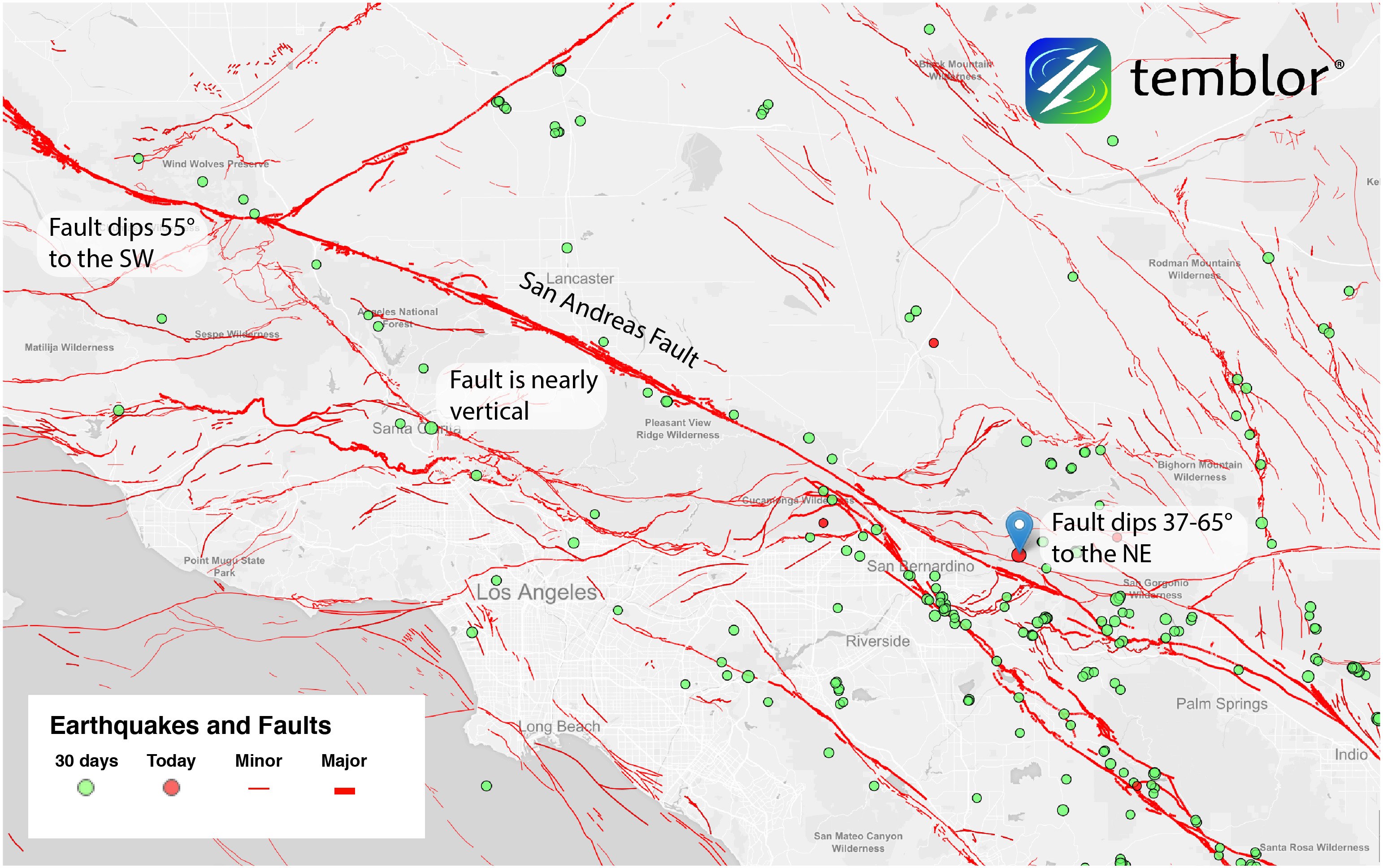By David Jacobson and Ross Stein, Temblor
Check your seismic hazard rank

At just past 2 a.m. local time, a M=3.4 earthquake within the San Andreas Fault Zone just east of Los Angeles woke residents from their nightly slumber. At 9 a.m. this morning, there were 436 felt reports on the USGS website. Having said that, based on the shaking, it is highly likely that many more felt it. Around the epicenter, there was moderate shaking, with weak shaking felt in and around Riverside.

This earthquake occurred in the San Andreas Fault Zone (SAFZ), along the San Bernardino Mountains section. On the basis of the M=3.4 earthquake location, depth, and ‘focal mechanism’ (its orientation and sense of slip), and the likely northeast dip of the San Andreas, the event probably lies on the Mill Creek Fault, very close to the NE-‘dipping’ (inclined) main strand of the San Andreas Fault. The Mill Creek Fault is a northern strand of the San Andreas Fault Zone as it slices through the San Bernardino mountains. According to Fuis et al., 2012, this portion of the main strand of the San Andreas Fault is inclined (‘dips’) about 40° to the northeast. This is an extremely shallow dip compared to other locations, where it becomes nearly vertical. Wenzheng Yang, Egill Hauksson, and Peter M. Shearer (2012) showed that both strike-slip and thrust slip events occur at this location. This event is almost purely strike-slip, which is perhaps most consistent with San Andreas motion.

While most people only focus on where faults are at the surface, the subsurface geometry of the southern San Andreas is quite intricate. As the San Andreas weaves its way through Southern California, it has many bends separated by straight sections. While in the straight portions, like along the Mojave Desert, fault dips often exceed 80°, in the bends, the story is quite different. Subsurface magnetic data shows that in areas such as San Bernardino and Indio, the fault dips between 37°-65° to the northeast. This is a striking difference compared to the dip of the San Andreas within the western Traverse Range, where it dips approximately 55° to the southwest.

Because of these variable dips, at depth, the southern portion of the San Andreas has a shape described as a crude propeller. In addition to being an interesting fact, this shape also has a profound effect on seismic hazard. When a fault ruptures, either side of it has a name, the hanging wall, or the footwall. This is determined by fault dip (See figure below). While both sides look similar, shaking within them is often very different. Studies have shown that shaking within the hanging wall can sometimes be more than double that within the footwall. This means that at sites equally distant from a fault, your hazard is higher if live on the hanging wall of a fault. This highlights how important location is to determining what your hazard is.

References
Caltech/USGS Southern California Seismic Network
Fuis et al., Bulletin of the Seismological Society of America, Vol. 102, No. 1, pp. 236–251, February 2012, doi: 10.1785/0120110041
Wenzheng Yang, Egill Hauksson, and Peter M. Shearer, Computing a Large Refined Catalog of Focal Mechanisms for Southern California (1981–2010): Temporal Stability of the Style of Faulting,” Bulletin of the Seismological Society of America, Vol. 102, No. 3, pp. 1179–1194, June 2012, doi: 10.1785/0120110311
USGS
- Earthquake science illuminates landslide behavior - June 13, 2025
- Destruction and Transformation: Lessons learned from the 2015 Gorkha, Nepal, earthquake - April 25, 2025
- Knock, knock, knocking on your door – the Julian earthquake in southern California issues reminder to be prepared - April 24, 2025
